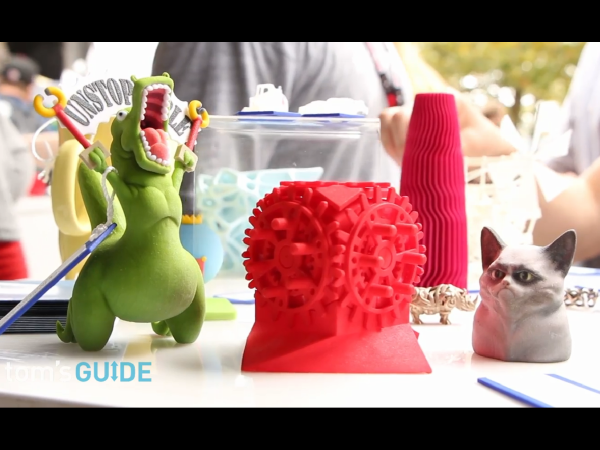The Future of 3D Printing Materials
3D printers are starting to print in metal. The next step is printing in multiple materials, and designing software that can keep up.

Ask any 3D printing enthusiast and they'll tell you that 3D printing is a dream come true: fast, customizable, and through online 3D printing community hubs like Shapeways and free design software, easy to access.
But what are those dreams made of?
Right now most 3D printers can only print in a handful of materials. But Carine Carmy, director of marketing at the 3D printing company Shapeways, says that the field is on the cusp of a huge change.
Most 3D printers, particularly the more affordable commercial ones such as the Cubify Cube, only print in plastics called ABS and PLA. Through Shapeways, people can choose from a library of uploaded digital designs, or submit their own to be printed on Shapeways' industrial-strength machines, which can print in a variety of plastics as well as ceramics, nylons and a few metals.
MORE: 5 Coolest 3D Printers of Maker Faire 2013
But no matter how many materials Shapeways adds to its offerings, the service—and commercial 3D printing in general—still has one big limitation: each object can only be printed out of one of those materials.
"How many products in your life are made out of one material?" Carmy pointed out.
Sign up to get the BEST of Tom's Guide direct to your inbox.
Get instant access to breaking news, the hottest reviews, great deals and helpful tips.
"Because you can't do mixed materials yet we do need to do some post-production [on the prints]," said Carmy, "but probably in the next year we'll see products that are fully assembled and in in mixed materials coming out of the printers."
"In the future we're going to start to see mixed materials, electronics 3D printing, and conductive materials as well," she told Tom's Guide.
That includes more metal offerings. Printing in metal is still fairly new to the field; before, designers would 3D print plastic moldings and then pour metal into them to make metal designs.
But now Shapeways is offering printing in materials like brass and stainless steel.
MORE: Forget Plastic: Molten Metal 3D Printers Are Coming
Some of these metals can conduct electricity, which is the first step towards 3D printing circuit boards and other electronic devices.
A type of photosensitive resin that hardens into a firm solid when exposed to light is also becoming a popular and useful 3D printing option.
As the materials become more complex, another consideration is how the 3D printing design software will keep up.
Designers need to consider the materials they'll be printing in as they create their digital designs, Carmy said, because the consistency, weight, and desired detail will have an effect on how the physical model looks.
"One of the biggest hurdles that we have today is that when you're designing products you actually have to think about the materials you're going to end up using because materials have different properties.
"The software needs to get smarter to give us that real-time feedback," said Carmy. "What are you designing for? What are the physical properties you need?"
Once software can help designers answer those questions and printers can create complex designs in multiple materials, people will be able to print almost anything — as long as they can dream it first.
Email jscharr@techmedianetwork.com or follow her @JillScharr. Follow us @TomsGuide, on Facebook and on Google+.
Jill Scharr is a creative writer and narrative designer in the videogame industry. She's currently Project Lead Writer at the games studio Harebrained Schemes, and has also worked at Bungie. Prior to that she worked as a Staff Writer for Tom's Guide, covering video games, online security, 3D printing and tech innovation among many subjects.
-
dogie Really, really bad article. This information is literally years old, and there is a world outside of material extrusion full of 100s of materials.Reply -
cmartin011 How about printing a printer and have to just buy materials fabricate more more printers lol got source of money?Reply -
MiguelKendrick "3D printing in general—still has one big limitation: each object can only be printed out of one of those materials."That's right. 3D printing materials has limitations that we should consider. Take note also of the importance of filament's tolerance. Make sure your filament is top of the line and find a good filament supplier. Quality filaments I found to date were from 3D2PRINT. I purchased 3mm and 1.75mm ABS and PLA (gold, silver and glow). You can shop more of it here: http://www.3d2print.net/shop/filament/Reply
